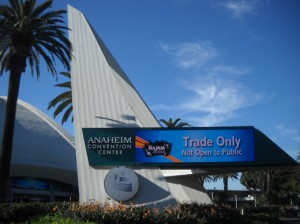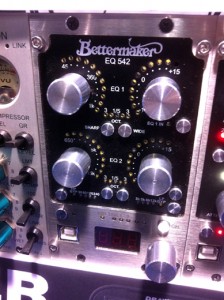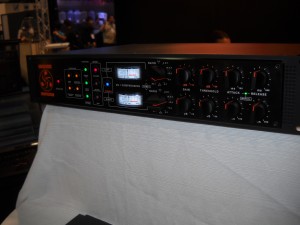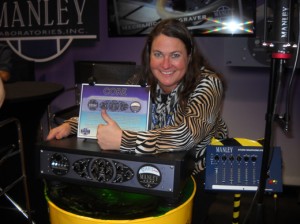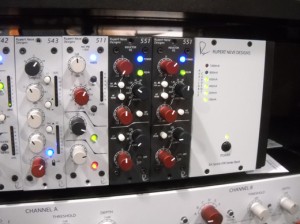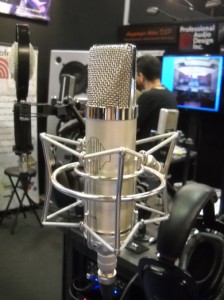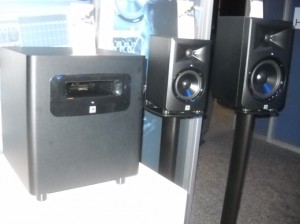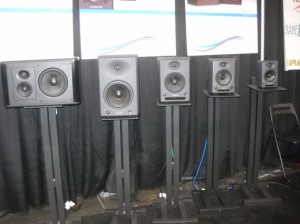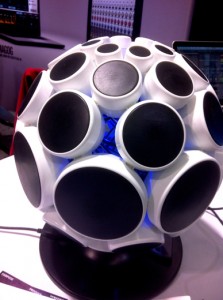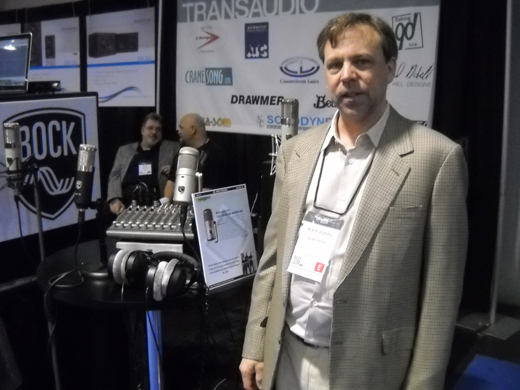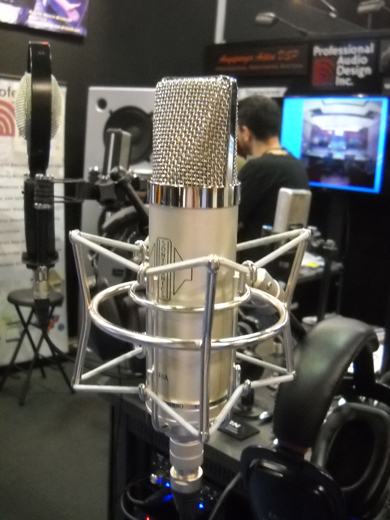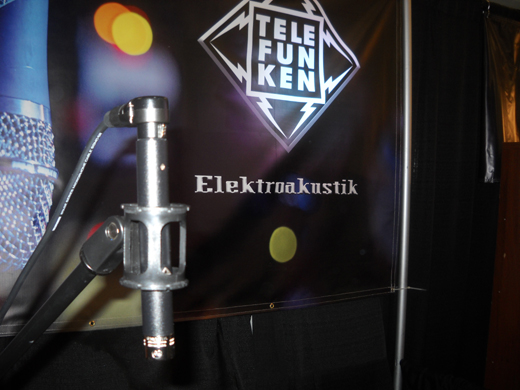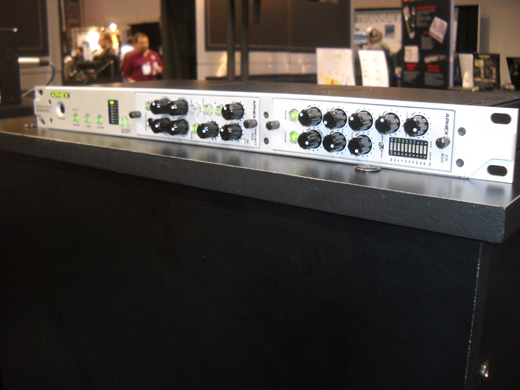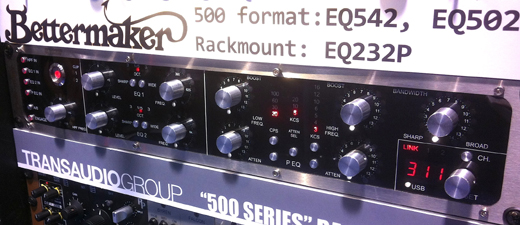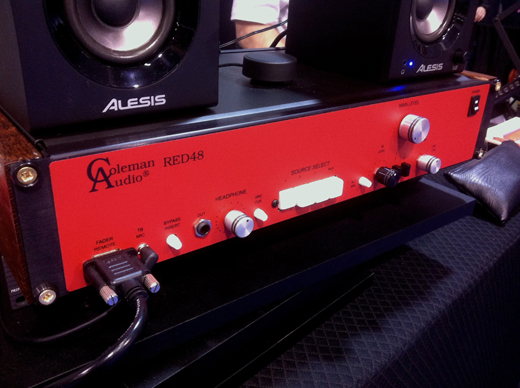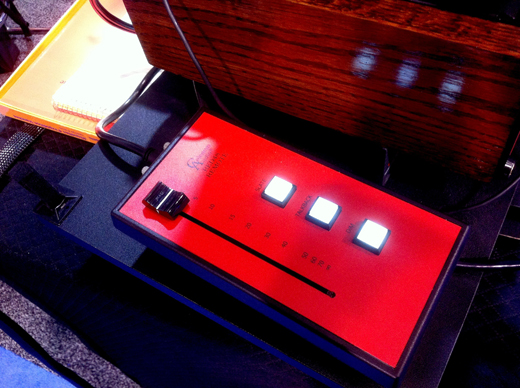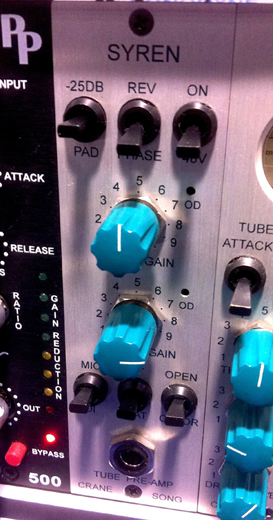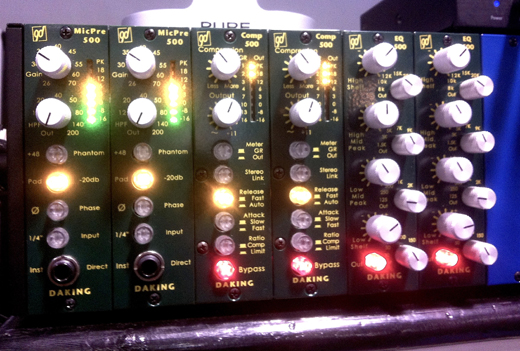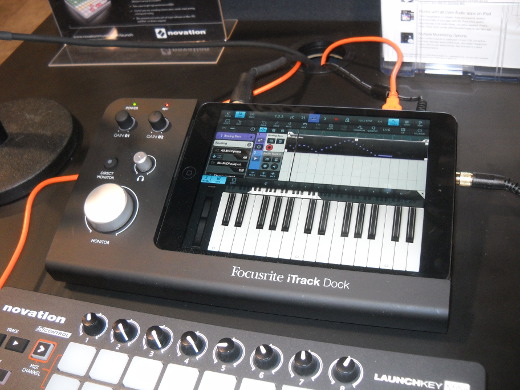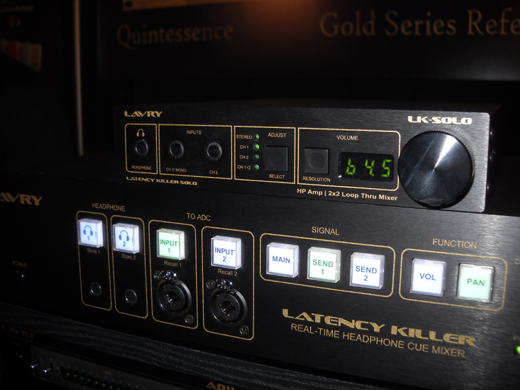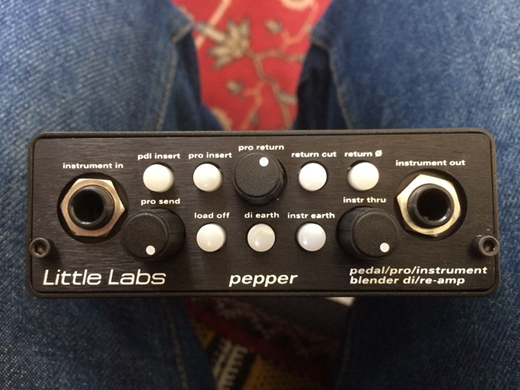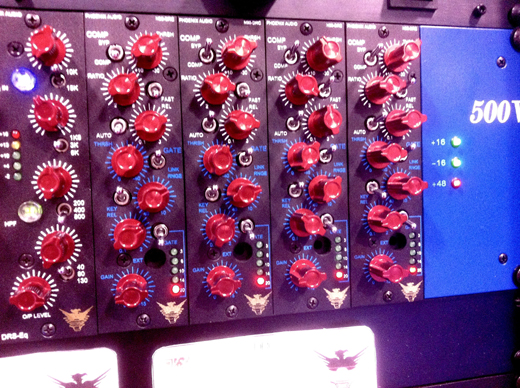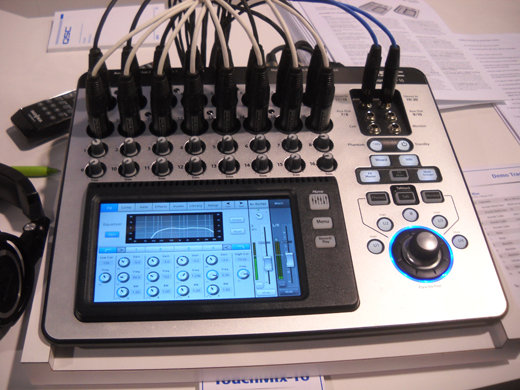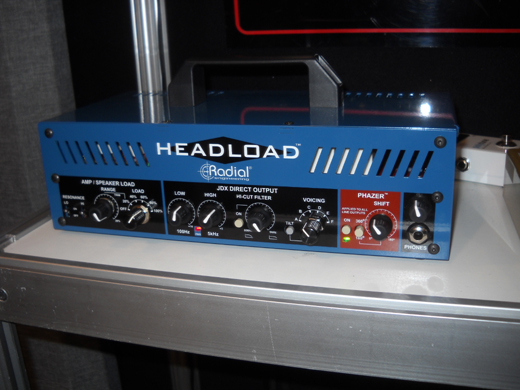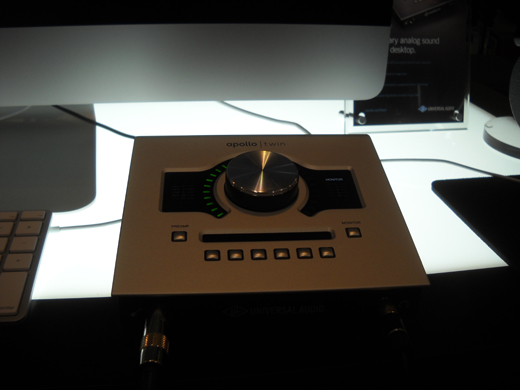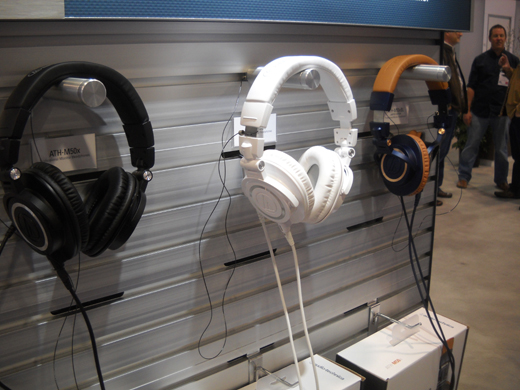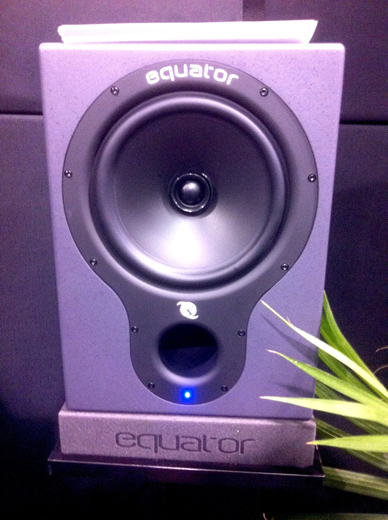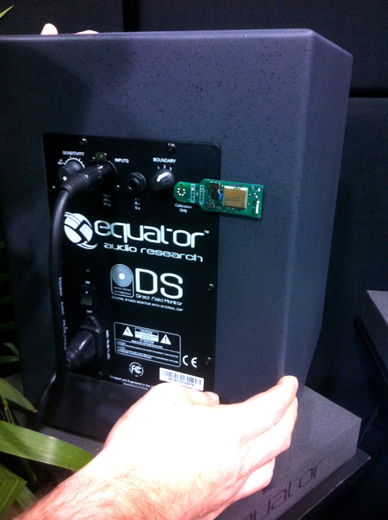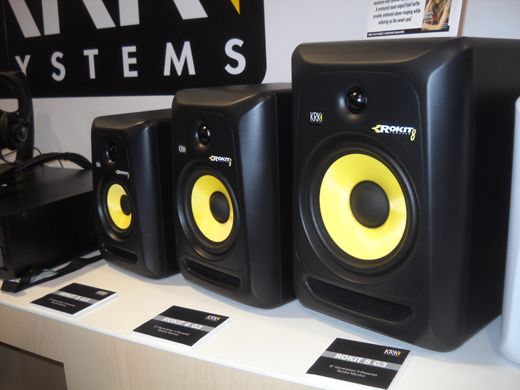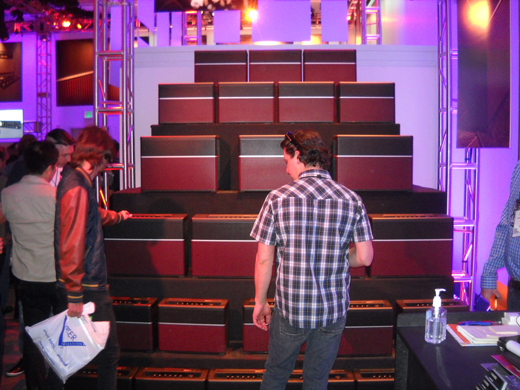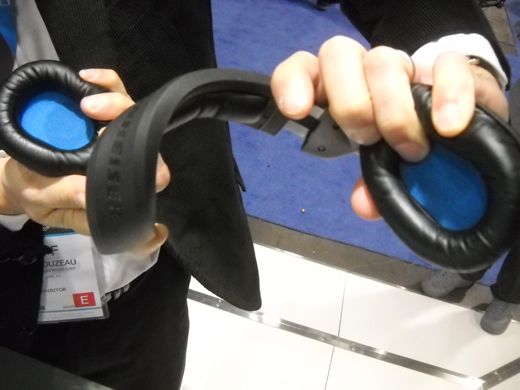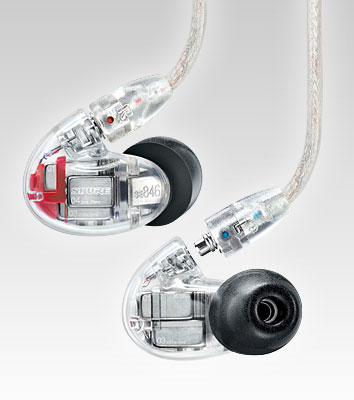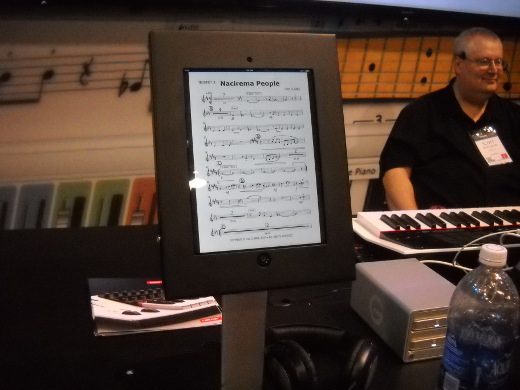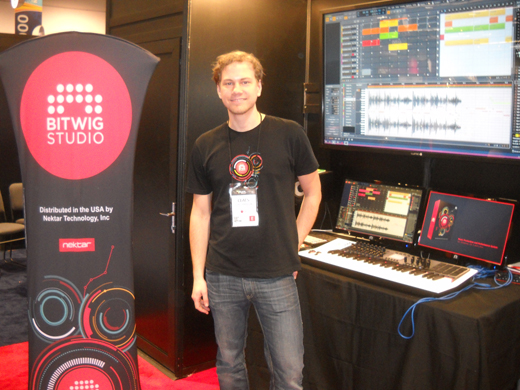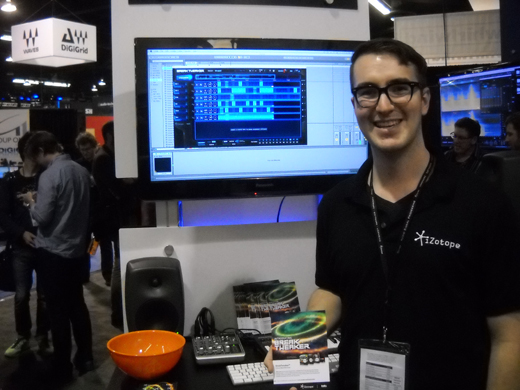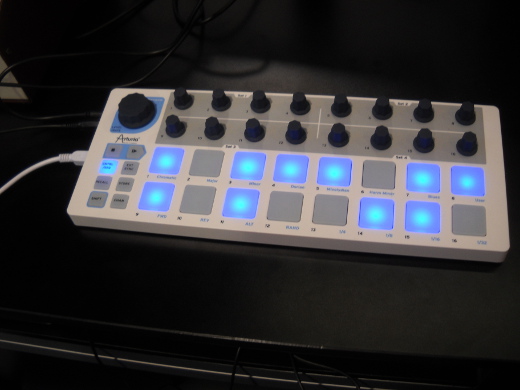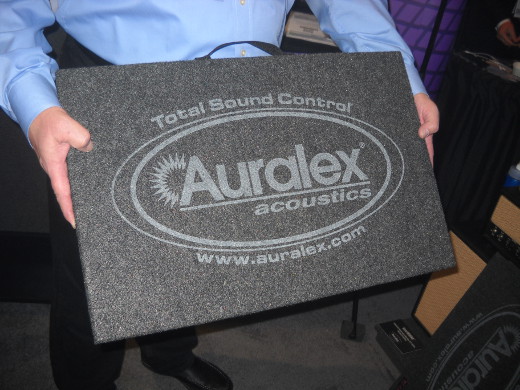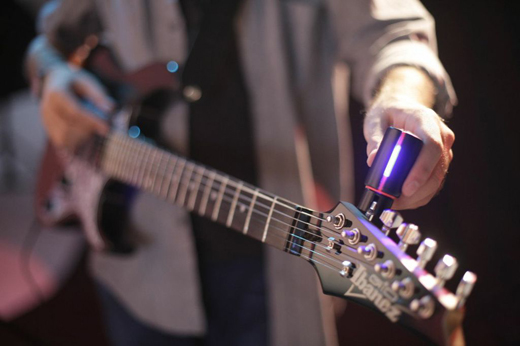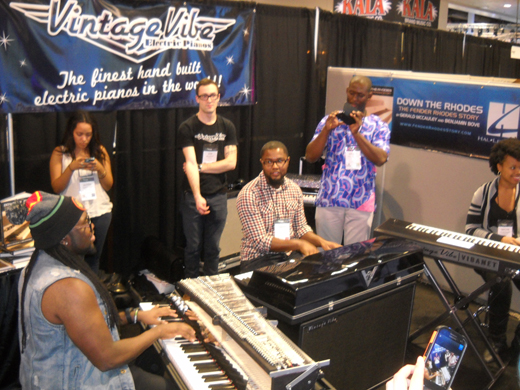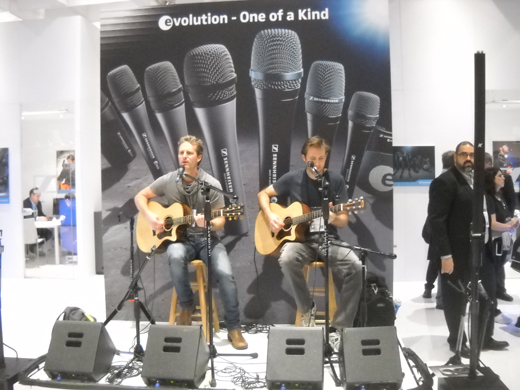NAMM 2014 Gear Highlights: 36 Picks to Improve Your Studio
If being thoroughly overwhelmed is your thing, then the music trade show they call NAMM is a great way to kick off the year.
The 2014 North American Music Merchants expo, held as always in sunny Anaheim, CA this past week, offered up its usual massive overload of instruments, gear, and people.
According to the organization, there were 5,010 different brands to feast your eyes and ears upon at this year’s show – if anyone tells you they saw them all, they’re probably suffering from the post-traumatic stress disorder that NAMM is fully capable of provoking.
The energy on the convention center floor was positive and pretty intense, pushing attendees and exhibitors along at a fast pace that never let up. The early arrival of the GRAMMY awards, broadcast on the same night as NAMM’s final day, also provided a welcome sense of motivation to all involved.
Those on the lookout for The Huge Breakthrough were probably disappointed – but they almost inevitably are. While there is still no holographic DAW interface, or mental mixing app on the market, hardware and software evolution is proceeding at a brisk pace: from monitors to 500 modules, audio interfaces to outboard gear, DAWs to digital drums, the tools used to produce music are constantly improving.
We combed NAMM looking for the latest and greatest that the industry is offering up to studios, producers, engineers, and artists. Without further ado, here’s what we experienced (click on any photo to enlarge — many more pictures are at the end of the article):
Outboard & Recording
AnaMod Realios A9052 EQ: This 500 series EQ module is based on the Olympic Studios Helios console designed by Dick Swettenham. Known for its incredibly musical characteristics, the new iteration of this EQ includes a class-A transistor output stage, a step-down input transformer and a step-up output transformer that pushes the headroom up by 6dB more than what 500 series modules typically allow.
Aphex D 500 DUO and Project 500 Channel Strip: Were always interested in what’s brewing at Aphex, and their booth didn’t disappoint in 2014. First off, we liked the D 500 DUO, a 500 series rack with analog and digital I/O – it offers S/PDIF digital inputs and outputs going up to 192k, 880mA power supplies for highly demanding 500 series modules, chaining and stereo linking, balanced inserts, and word clock in/out ($499 MAP). Aphex also showed the project 500, a unit that they say is the first full channel strip in a 500 series module – that’s a class a mic preamp, optical compressor, and dual-Dan semi-parametric EQ in one little space ($399 MAP). Availability commences in March.
Bettermaker EQ 232P & EQ 232P Remote: A marriage of analog and digital, this clean sounding, versatile EQ unit features discrete analog processing with digital control. With a classic Pultec section, this EQ includes 999 user presets with instant recall. Using a USB link, the 232P can act as a plug-in, with AU, VST, and RTAS capability at both 32 and 64 bit. Furthermore, you can save these presets not only in the unit itself, but in your DAW and in your individual sessions with automation. Pulling more of the plug-in mentality into the analog world, the 232P also allows you to A/B between settings.
Bettermaker EQ 542: This is essentially the 500 series version of the Bettermaker EQ 232P with 399 user presets, steel screen isolators for analog/digital separation and connectivity of up to 99 EQ 542s to one DAW, controlled via plug-in.
Coleman Red 48: Analog console features in a compact piece of gear with three basic sections: control room monitor, communications and the mix buss. In short, the control room monitor section is made up of a passive stepped attenuator and a remote dim switch, located on the classic P&G fader box. Also on the remote fader box are slate and talkback switches. The communications section is a talk back mic and a level control summing into the headphones. The mix buss section has 48 hard left and right (24 stereo) analog inputs that sum to left and right. Other features include three balanced input sources in the control room selector section, alternate speaker source, built in talk back mic with input for external talk back switch, and engineer headphone out with separate level control that selects either the cue feed or control room signal.
Crane Song Syren: A classic tube pre-amp in a compact 500 series module. Versatile in its design, the Syren has a dual gain stage allowing for overdrive and a choice of negative feedback through the second stage to change the color of the sound. By changing how the two tube stages interact, the pre-amp can deliver a wider frequency response and a clearer, more accurate sound when negative feedback is utilized, while creating a more open, classically warm sound without negative feedback.
Daking 500 Recording System: A fully stocked 500 lunchbox system that includes two mic pres, two compressors, two EQ’s and an API PSU. Made with Class A circuitry and discrete transistor technology, the modules are high performance with low current draw. The Pres include Jensen transformers, 70dB of gain and an instrument jack direct input on the front panel. The Compressors include single-sided amplifiers delivering high headroom, fast and transparent compression and a stereo link that allows for “any number” of units to be linked. Finally, the EQ’s also use single-sided amplifiers and offer five frequency selections in each band, high and low shelving and inductor based high and low mid peaking. Also, according to the Daking cut sheet, the EQ’s are gluten free.
Dangerous Compressor: NAMM is where we got our first good look at the Dangerous Compressor, coming in February for $2799. An all-VCA design, it displays virtually no distortion even with 20 DB gain reduction. Its simple layout is easy to master, featuring tools like Dangerous’ “Smart Dyn Dual Slpe Detection” which automatically limits errant peaks while it compresses the average, and a time-saving auto attack/release. Its transparent sound is made all the sweeter with niceties like internal sidechain circuitry, bass cut, and sibilance boost.
Focusrite iTrack Dock: Another device generating steady interest was the iTrack Dock from Focusrite. We covered the launch earlier on SonicScoop, but feeling the substantial build of this professional dock for iPad recording took our appreciation to the next level. A high quality portable interface, it features two preamps from the Focusrite Scarlett range of USB interfaces. Especially fun was trying it with the free Tape app, which makes it incredibly fast and easy to record a track and upload it directly to SoundCloud.
Lavry Engineering LK-Solo: This intriguing new unit from the mind of Dan Lavry should make its way into many Studios this year. A 1/2 rack-size version of the original 2RU latency killer, the solo serves two functions. First, it serves as a high-quality headphone amplifier with super-accurate analog stepped volume control (½ dB increments). But it’s also an extremely useful tool for 2-channel recording and overdubbing, which gives the performer 100% zero latency from any digital recording system. In essence, the LK-Solo contributes zero signal distortion and noise to the recording, due to the fact that each LK-Solo output connector is hardwired to the respective input connector — with no electronics in the signal path between. As Lavry points out, mixers place many additional circuits in the signal path, adding coloration, phase distortion, and noise to the signals, but the LK-Solo does not. Intrigued? Definitely give it a try.
Little Labs Pepper: The intermediary between pro gear and guitar gear allowing you to blend pedal effects with pro audio effects, such as a rack of compressors or EQ’s. Both inputs have a hard bypass and there’s an instrument thru so the user can blend in a dry guitar signal for more attack and intelligibility. Built with hi-fi differential op-amps and UTC style transformers, it’s pro audio with musician capabilities, including a mic-level DI out and level matching capabilities to ensure insert in and out level matching for re-amping purposes.
Manley Core: One of the most buzzed about new releases in the Pro audio section was the Manley CORE reference channel strip. Designed with the working musician firmly in mind, the unit sports a very efficient yet attractive layout, allowing home studio producers to dial in their sound faster. Fewer knobs, fewer dollars – at just $2,250 retail the CORE puts a Manley tube-driven channel strip complete with mic preamp, compressor, EQ and limiter combo-unit, within reach. Availability is slated for end of March.
Phoenix N90-DRC/500: Designed by David Rees, this is a reconfigured 500 series compressor/gate with class A amplification and VCA control. Wanting to steer away from engineering with your eyes, this piece is meant to be used “by ear,” with no “perfect” settings for all situations. The compression is musical and smooth; inaudible processing due to the hi-fi components and classic design.
QSC TouchMix: More than one informer told us that we HAD to swing by the QSC booth and see what was a-brewin’. There we saw the TouchMix, a compact digital mixer designed for musicians, production pros, and live performance venues. Described by QSC as the sonic equivalent of a “point and shoot” digital camera, it’s a completely self-contained system designed to get great results quickly. The TM-16 (there’s also an 8-channel version) has 20 inputs, 4-band full parametric EQ, touchscreen GI, direct t0 hard-drive recording and playback of mutitrack .WAV files, and remote control via mobile devices. Judging from the buzz, QSC may have a hit on its hand with its very first mixer.
Radial Engineering Space Heater and HeadLoad: It’s a safe bet that you’ll find something innovative and interesting at Radial Engineering, and that held true again in 2014. We loved getting a look at the Space Heater 8-channel tube drive summing amp, which promises to bring attitude to mixing in the box. And recordists and performers alike will get off on the Headload guitar amplifier and attenuator, a smart design that allows to reduce their volume levels even while driving the amp hard for maximum tone. After witnessing the demo we saw how it would not only be a help onstage, but to home and personal studio recordists who crave a huge guitar sound without being able to make it too too loud. If you lack the amp closet or fully isolated live room, this is a welcome solution.
Rupert Neve Designs 551 500 Series Inductor EQ: SonicScoop readers were ecstatic about the recent announcement of this unit, the first and only 500 series EQ designed by Rupert Neve himself. We certainly enjoyed seeing this black beauty in person…touching it…FEELING his audio aura. Featuring three bands of EQ inspired by Neve’s beloved vintage designs, custom-wound inductors, transformers and class-A gain blocks, all for $950, it’s a welcome chance to have Rupert in the room.
Universal Audio Apollo Twin: Introduced at NAMM, the Universal Audio Apollo Twin is an extremely solid-feeling desktop audio interface, bolstered by a big package of classic UAD plugins, with the new Unison preamp technology. We can see the Twin proving to be a serious contender for the attention of singer/songwriters, touring musicians, and anyone else who wants an extremely high quality interface in a compact – and affordable (priced under $1,000) – form factor.
Microphones
Blue Microphones “Hampton”: Another SCOOP on display was Blue’s upcoming small diaphragm pencil condenser mic. Code-named “Hampton” and coming out later in 2014 for under $500, it will provide great transient response and features an extremely convenient rotating mic head, for perfect placement. While a whiz-bang teaser AV presentation was running for their much ballyhooed Mo-Fi headphones, alas the cans were not onsite.
Bock Audio iFet: Spied at the Trans Audio Group booth was not just the mic, but the man behind it. We saw this phantom powered (P48) FET condenser mic before, but we still love that it’s two mics in one – it has two different sets of electronics (mic amplifiers) sharing a K47 type capsule and large core, specially-designed Bock output transformer. The result is two “modes” for the Bock iFet that offer two distinctly different sounds: the ideal FET mic for kick drums, and a classic FET vocal mic for a plethora of voices.
Sontronics ARIA Valve Mic: At the Professional Audio Design booth, we were treated to our first look at the lovely Sontronics ARIA microphone. A valve condenser mic with a fixed cardioid pattern, it was designed by company founder Trevor Coley specifically as a secret weapon for tracking vocals. The UK-based Coley outfitted ARIA with a large 1.07-inch edge-terminated capsule, a hand selected European tube, and an accompanying power supply with pad and filter switches, plus a “tube ready” LED indicating that the mic is properly warmed up. Beta-tested by Paul Epworth, PJ Harvey, and multiple Abbey Road engineers, the ARIA sports silky smoothness, accurate response, and a smooth high-frequency roll off. It is available now for $1,199.
Telefunken M60 FET: There’s nothing we like better than a good SCOOP, and that’s exactly what we got when we traversed the Telefunken booth. Hiding in plain sight was their upcoming M60 FET, a solid state beauty that represents their first non-vacuum tube-based condenser mic. Built with the same capsules as the mighty ELA M 260, this mic should be a honey for drum overheads, acoustic guitar piano, and other instruments. Availability will commence in the beginning of Q3.
Monitors, Headphones, & Amplifiers
Audio-Technica ATH-M50x Headphones: Another NAMM first look was happening at the Audio-Technica booth, where a steady stream of visitors were experiencing the newly introduced ATH-M50x headphones. The deluxe version of their recently re-imagined M-Series headphone line, it shares the sound of their top-of-the-line ATH-M50, while adding refined ear pads and three detachable cables. Designed for recording, mixing, broadcast, DJ, live sound, and personal listening applications, we found these headphones to be extremely comfortable while delivering very clear and accurate sound. They will be available starting in February, with a price range between $239 and $259, depending on the color scheme.
Equator D8: The latest from the company best known for their unique co-axial driver design where the tweeter sits in the center of the bass/mid driver. The D8 is a larger and more technologically advanced version of the D5s. In short, this speaker can be several. Using a wi-fi powered dongle that plugs into the back of the monitor, the user can choose from 3 or 4 presets, including NS10s, Auratones or simply a flat D8 response. The DSI software is both Mac and PC compatible and allows the user to access the internal DSP of the speakers, to not only set presets but make subtle changes in the EQ to better suit various listening situations. When listening to the flat D8 response, the speakers are tremendously clear without being too nice. They deliver transparent, honest sound with impressive stereo imaging, depth and focus.
JBL 3 Series Monitors: We were very impressed by our first listen of this group of powered studio monitors, plus subwoofer. Boasting the waveguide technology from JBL’s flagship M2 Master Reference monitors, they create a sizable sweet spot and illustrate great detail in the sonics. With the 305 priced at $149, the larger 308 at $249, and the 10-inch 200 W sub at $499, the 3-series provides excellent value to the personal studio producer.
KRK ROKIT Generation 3: We got our first listen to this latest addition in KRK’s series of studio monitors. Ranging in price from $149 for the 50 watt ROKIT 5 to $249 for the 100 watt ROKIT 8, they put out plenty of power with very realistic imaging. Watch out for the white versions coming soon – they’ll blind you with science!
Line 6 AMPLIFI: Upstairs from the main hall, Line 6 likes to maintain its own personal complex. Visitors to their room were greeted with a pyramid of AMPLIFI – what Line 6 is describing as an entirely new kind of guitar amplifier. And they just might be right: it converges a high-performance 5-speaker stereo design guitar amp, streaming Bluetooth capability, and an iOS app control & cloud connection. Available in 150-watt ($499) or a more portable 75-watt ($399) version, AMPLIFI covers an extremely wide frequency spectrum, and can even match its tones to the music library selections that are being streamed through it. Plus, favorite and customized guitar tones can be shared and stored in the cloud, making AMPLIFI a strong resource for tone discovery. Ideal for jamming or intensive home-listening, it’s a “digital lifestyle device” and uniquely versatile new addition to the music world.
Sennheiser HD8 DJ Headphones: Sennheiser had a tough act to follow with its long-running HD 25 DJ headphones. However, it looks like they may have surpassed their reputation with the newly introduced line of professional mixing and DJ cans. In addition to the HD 8 headphones http://en-us.sennheiser.com/on-ear-headphones-stereo-hd8-dj you see here twisting the day away, Sennheiser also unveiled the HD6 Mix ($279.95) and HD7 DJ ($329.95). We thought the HD8 ($389.95) sounded amazing, felt extremely comfortable — and clearly have built-in durability.
Shure SE846 Sound Isolating Earphones: Moving from on-ear to in-ear, we were blown away by our first listen of the Shure SE846 (MAP $999) . Built with quad high-definition micro drivers and a sure-as-shootin’ subwoofer, these were created to put as much sound as possible safely into your ear canal. Customizable frequency response only sweetens the deal. Ideal for onstage use or extremely high-fi personal listening.
Sonodyne SRP Studio Monitors: Known for their unique capabilities when it comes to power amplifiers, electronics integration, and acoustics + die cast cabinet technology, Sonodyne launched their expansive new range of competitively-priced SRP monitors at NAMM. Available for between $800-$2500/pair, the SRP line is distinguished by a unique acoustic waveguide, resulting in clear, detailed high frequency response over a wide sweet spot. Meanwhile, an aluminum pressure die cast molded enclosure eliminates vibrations and standing wave buildup, for a smooth and extended low frequency response and detailed midrange. Neodymium magnet HF tranducers, a Kevlar cone, DSP enabled biamplifier, and toroidal transformers are all employed in the design.
Software
Avid Sibelius 7.5: Avid has made its commitment to Sibelius plain with the release of Version 7.5. It will ship with the Sibelius Sounds library, which includes 36+ GB of content, including a specially recorded Symphony Orchestra, rock, and pop instruments. Also impressive was the “Espressivo 2.0” feature, which allows for entirely new levels of expressiveness; the extremely deep collaboration and sharing features for publishing to ScoreExchange, and even as video or audio files on YouTube, Facebook, and SoundCloud. Finally, full Scorch app integration allows composers to optimize their scores for iPad display. Availability is “soon”.
Bitwig Studio 1.0 –It’s not every day that a new DAW comes along, so we found ourselves magnetically attracted to Bitwig Studio 1.0. Designed by a team of rebellious programmers, its attractive interface offers a notably fast, creative and musical workflow. A tabbed document interface allows users to have multiple projects open at the same time, with drag and drop between them. A Clip Launcher can draft a songs layout on the fly, or be used exclusively as a performance tool. Or trip out on the Dynamic Object Inspector, for intuitive note/event editing. Plus, multiple audio events are possible per clip, allowing for the automatic cutting of samples and on-the-fly rearranging. Bitwig Studio debuts in March, for $399.99 MAP.
iZotope BreakTweaker: It’s safe to say we dug upon BreakTweaker, the “future beat machine” from iZotope. Designed by BT himself, this is a highly flexible tool for making beats. Getting glitchy is just the beginning – you can use it to introduce melodic elements to your grooves, and invent new rhythms you would never even have dreamed of without it.
Instruments & Controllers
Arturia Beatstep: It wasn’t difficult to see the potential for the new Arturia BeatStep. A gorgeous portable pad controller, it has MIDI, CV, and USB connectivity, meaning that it can trigger everything from Live clips to vintage analog synths. A 16-step analog sequencer as well, there are a lot of groovy tunes you can imagine putting in motion with BeatStep. It ships in March for $129.
Nu Desine Alphasphere: One of the more fun pieces at NAMM, this USB globe-like device has 48 pressure and velocity sensitive pads that serve as MIDI triggers. The Alphasphere can be mapped and programmed using existing 3rd party software or the custom AlphaLive software. Polyphonic, with loop, and trigger capabilities, it can also be used to for lighting and visual setups.
Outside the Box
Auralex Gramma: Visitors to the Auralex booth were treated to a sneak peek of the next-generation GRAMMA (Gig and Recording, Amp and Monitor, Modulation Attenuator). The company’s patented device for floating amps or loudspeakers is about to get a host of improvements including new materials and a better handle (no small consideration for the gigging musician). The outcome: enhanced performance with a lower profile.
Roadie Tuner: A fully mechanized automatic guitar tuner with accompanying iPhone app technology. When tuning an electric guitar, plug your 1/4” into a mini adapter into your iPhone (Android compatibility on its way). The Roadie tuner app allows you to select your tuning and as you hit a string, using Bluetooth technology, the Roadie tuner will spin the tuning peg to the appropriate pitch. When tuning an acoustic guitar, the same Bluetooth technology applies, but uses the onboard microphone instead of a cable.
— Eleanor Goldfield & David Weiss
Please note: When you buy products through links on this page, we may earn an affiliate commission.







